University Linear Algebra Homework: Solutions Included
VerifiedAdded on 2021/04/24
|9
|908
|25
Homework Assignment
AI Summary
This homework assignment solution covers several core concepts in linear algebra. The solution begins with solving systems of linear equations using Gaussian elimination and then proceeds to calculate determinants of matrices. The assignment also explores Cramer's rule for solving linear systems, including the calculation of determinants for this purpose. Furthermore, the solution analyzes quadratic equations within a matrix context, including the formation of matrices from given points and the subsequent determination of coefficients. Finally, the solution examines linear transformations, including the verification of linearity, and the transformation of vectors within a given transformation framework. The document provides detailed, step-by-step solutions to each problem, demonstrating the application of key linear algebra principles.
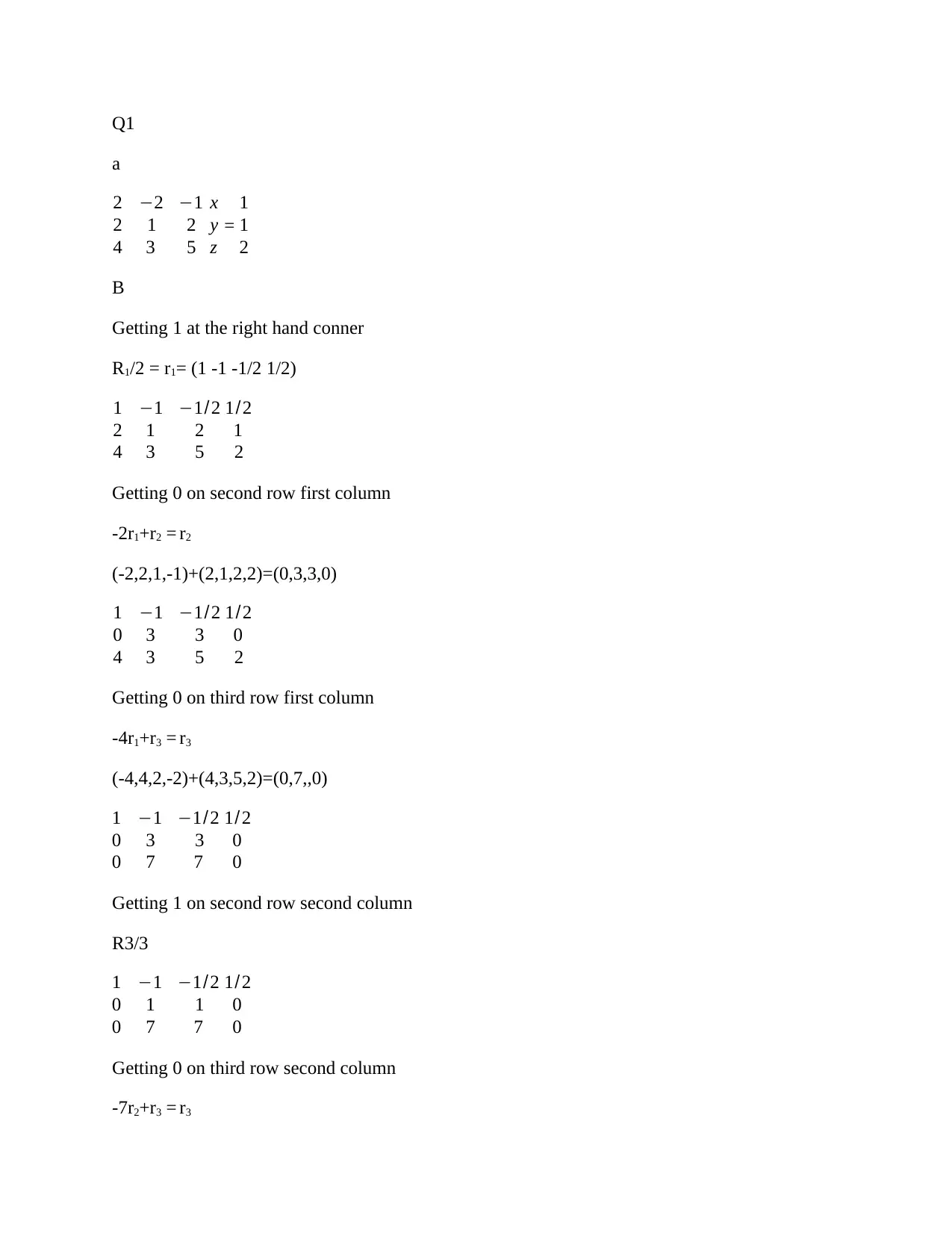
Q1
a
2 −2 −1
2 1 2
4 3 5
x
y
z
=
1
1
2
B
Getting 1 at the right hand conner
R1/2 = r1= (1 -1 -1/2 1/2)
1 −1 −1/2
2 1 2
4 3 5
1/2
1
2
Getting 0 on second row first column
-2r1+r2 = r2
(-2,2,1,-1)+(2,1,2,2)=(0,3,3,0)
1 −1 −1/2
0 3 3
4 3 5
1/2
0
2
Getting 0 on third row first column
-4r1+r3 = r3
(-4,4,2,-2)+(4,3,5,2)=(0,7,,0)
1 −1 −1/2
0 3 3
0 7 7
1/ 2
0
0
Getting 1 on second row second column
R3/3
1 −1 −1/2
0 1 1
0 7 7
1/ 2
0
0
Getting 0 on third row second column
-7r2+r3 = r3
a
2 −2 −1
2 1 2
4 3 5
x
y
z
=
1
1
2
B
Getting 1 at the right hand conner
R1/2 = r1= (1 -1 -1/2 1/2)
1 −1 −1/2
2 1 2
4 3 5
1/2
1
2
Getting 0 on second row first column
-2r1+r2 = r2
(-2,2,1,-1)+(2,1,2,2)=(0,3,3,0)
1 −1 −1/2
0 3 3
4 3 5
1/2
0
2
Getting 0 on third row first column
-4r1+r3 = r3
(-4,4,2,-2)+(4,3,5,2)=(0,7,,0)
1 −1 −1/2
0 3 3
0 7 7
1/ 2
0
0
Getting 1 on second row second column
R3/3
1 −1 −1/2
0 1 1
0 7 7
1/ 2
0
0
Getting 0 on third row second column
-7r2+r3 = r3
Paraphrase This Document
Need a fresh take? Get an instant paraphrase of this document with our AI Paraphraser
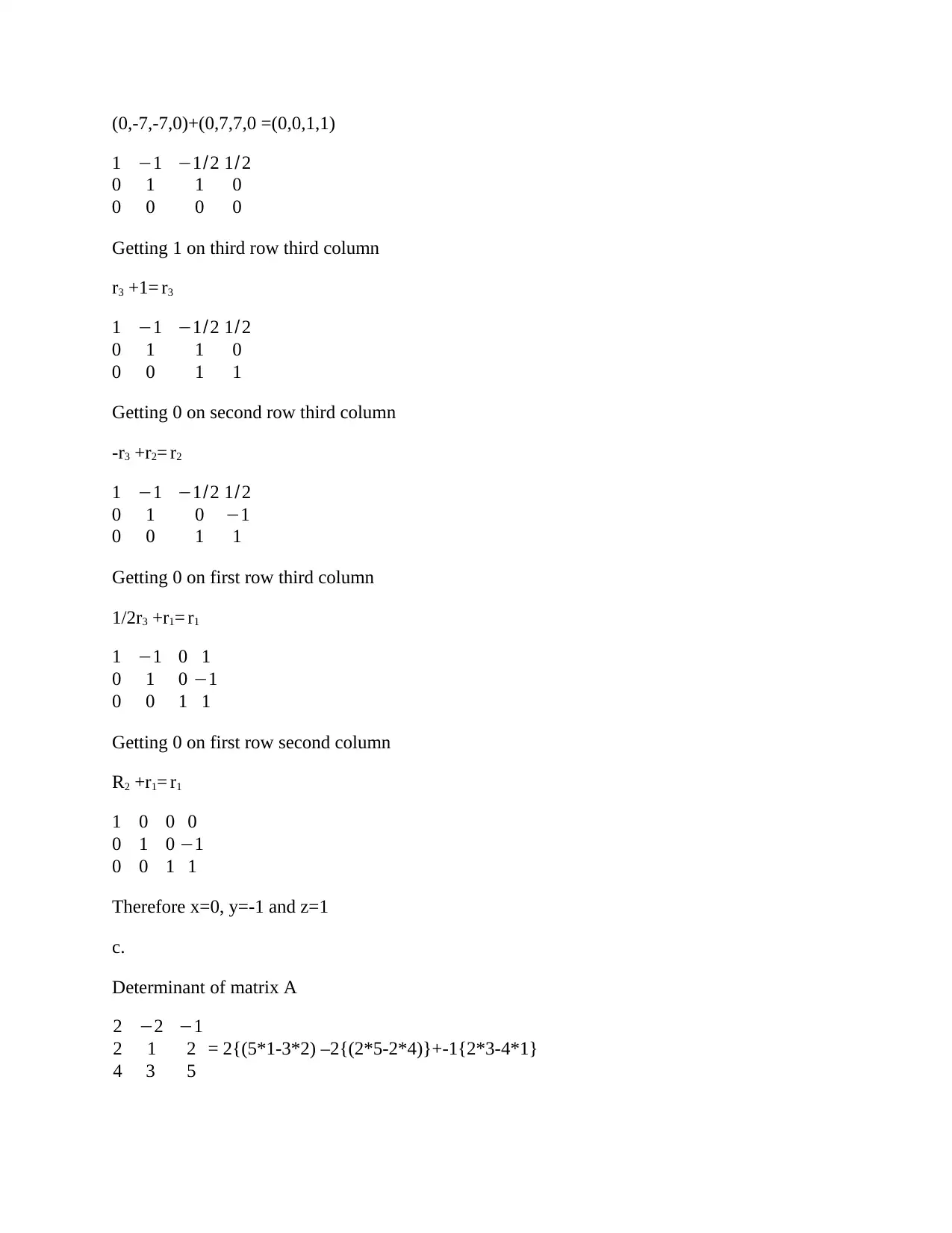
(0,-7,-7,0)+(0,7,7,0 =(0,0,1,1)
1 −1 −1/2
0 1 1
0 0 0
1/ 2
0
0
Getting 1 on third row third column
r3 +1= r3
1 −1 −1/2
0 1 1
0 0 1
1/ 2
0
1
Getting 0 on second row third column
-r3 +r2= r2
1 −1 −1/2
0 1 0
0 0 1
1/ 2
−1
1
Getting 0 on first row third column
1/2r3 +r1= r1
1 −1 0
0 1 0
0 0 1
1
−1
1
Getting 0 on first row second column
R2 +r1= r1
1 0 0
0 1 0
0 0 1
0
−1
1
Therefore x=0, y=-1 and z=1
c.
Determinant of matrix A
2 −2 −1
2 1 2
4 3 5
= 2{(5*1-3*2) –2{(2*5-2*4)}+-1{2*3-4*1}
1 −1 −1/2
0 1 1
0 0 0
1/ 2
0
0
Getting 1 on third row third column
r3 +1= r3
1 −1 −1/2
0 1 1
0 0 1
1/ 2
0
1
Getting 0 on second row third column
-r3 +r2= r2
1 −1 −1/2
0 1 0
0 0 1
1/ 2
−1
1
Getting 0 on first row third column
1/2r3 +r1= r1
1 −1 0
0 1 0
0 0 1
1
−1
1
Getting 0 on first row second column
R2 +r1= r1
1 0 0
0 1 0
0 0 1
0
−1
1
Therefore x=0, y=-1 and z=1
c.
Determinant of matrix A
2 −2 −1
2 1 2
4 3 5
= 2{(5*1-3*2) –2{(2*5-2*4)}+-1{2*3-4*1}
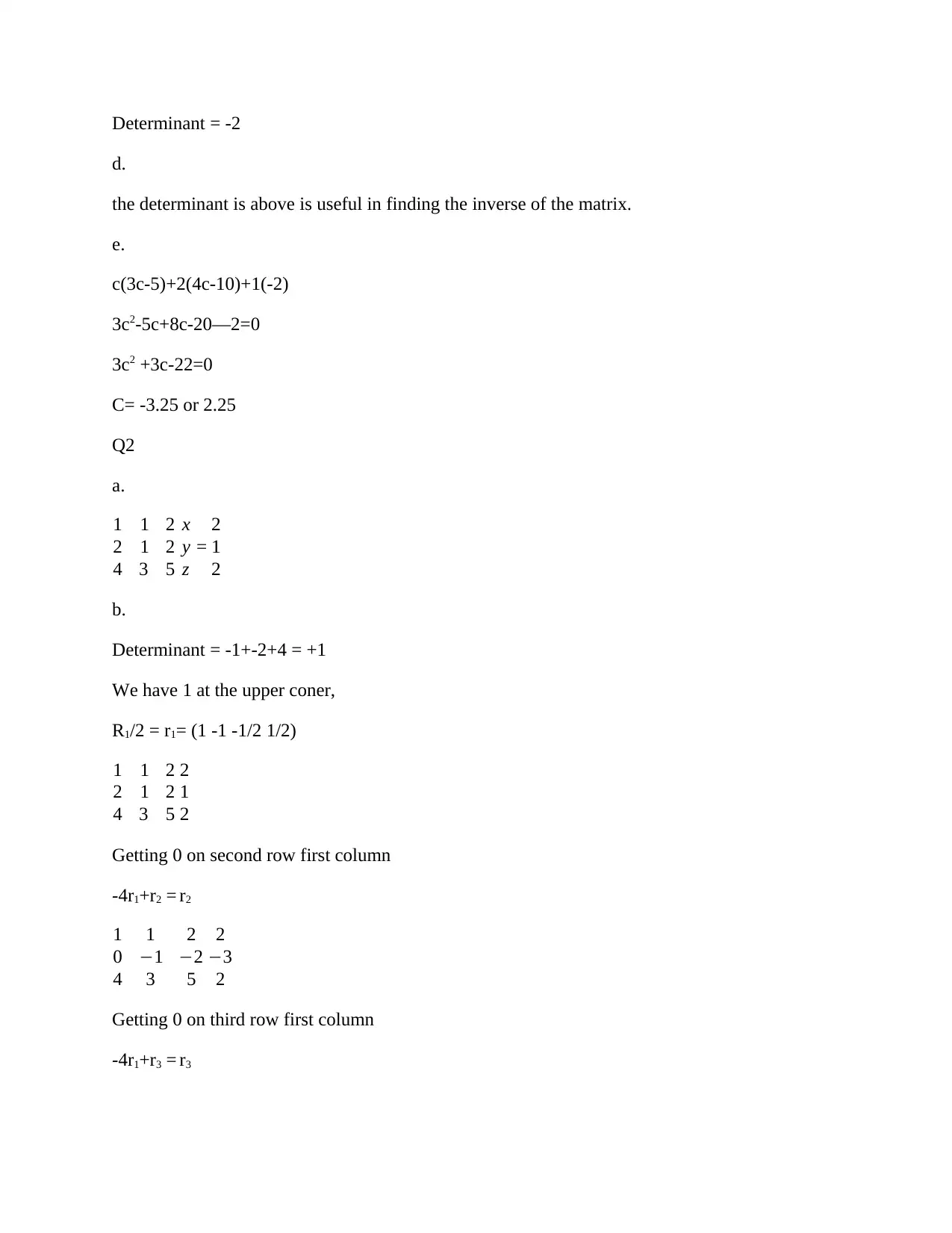
Determinant = -2
d.
the determinant is above is useful in finding the inverse of the matrix.
e.
c(3c-5)+2(4c-10)+1(-2)
3c2-5c+8c-20—2=0
3c2 +3c-22=0
C= -3.25 or 2.25
Q2
a.
1 1 2
2 1 2
4 3 5
x
y
z
=
2
1
2
b.
Determinant = -1+-2+4 = +1
We have 1 at the upper coner,
R1/2 = r1= (1 -1 -1/2 1/2)
1 1 2
2 1 2
4 3 5
2
1
2
Getting 0 on second row first column
-4r1+r2 = r2
1 1 2
0 −1 −2
4 3 5
2
−3
2
Getting 0 on third row first column
-4r1+r3 = r3
d.
the determinant is above is useful in finding the inverse of the matrix.
e.
c(3c-5)+2(4c-10)+1(-2)
3c2-5c+8c-20—2=0
3c2 +3c-22=0
C= -3.25 or 2.25
Q2
a.
1 1 2
2 1 2
4 3 5
x
y
z
=
2
1
2
b.
Determinant = -1+-2+4 = +1
We have 1 at the upper coner,
R1/2 = r1= (1 -1 -1/2 1/2)
1 1 2
2 1 2
4 3 5
2
1
2
Getting 0 on second row first column
-4r1+r2 = r2
1 1 2
0 −1 −2
4 3 5
2
−3
2
Getting 0 on third row first column
-4r1+r3 = r3
⊘ This is a preview!⊘
Do you want full access?
Subscribe today to unlock all pages.

Trusted by 1+ million students worldwide
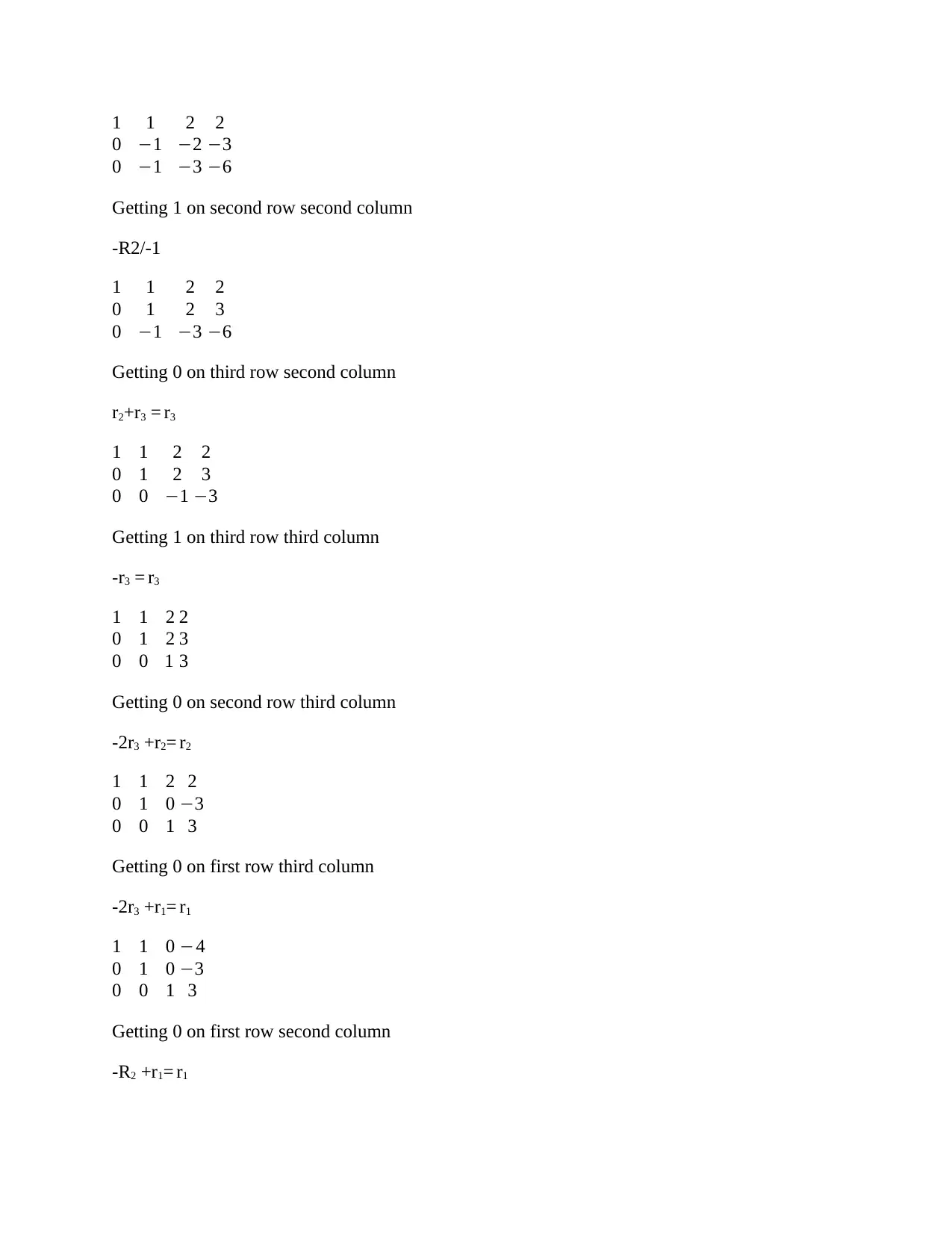
1 1 2
0 −1 −2
0 −1 −3
2
−3
−6
Getting 1 on second row second column
-R2/-1
1 1 2
0 1 2
0 −1 −3
2
3
−6
Getting 0 on third row second column
r2+r3 = r3
1 1 2
0 1 2
0 0 −1
2
3
−3
Getting 1 on third row third column
-r3 = r3
1 1 2
0 1 2
0 0 1
2
3
3
Getting 0 on second row third column
-2r3 +r2= r2
1 1 2
0 1 0
0 0 1
2
−3
3
Getting 0 on first row third column
-2r3 +r1= r1
1 1 0
0 1 0
0 0 1
−4
−3
3
Getting 0 on first row second column
-R2 +r1= r1
0 −1 −2
0 −1 −3
2
−3
−6
Getting 1 on second row second column
-R2/-1
1 1 2
0 1 2
0 −1 −3
2
3
−6
Getting 0 on third row second column
r2+r3 = r3
1 1 2
0 1 2
0 0 −1
2
3
−3
Getting 1 on third row third column
-r3 = r3
1 1 2
0 1 2
0 0 1
2
3
3
Getting 0 on second row third column
-2r3 +r2= r2
1 1 2
0 1 0
0 0 1
2
−3
3
Getting 0 on first row third column
-2r3 +r1= r1
1 1 0
0 1 0
0 0 1
−4
−3
3
Getting 0 on first row second column
-R2 +r1= r1
Paraphrase This Document
Need a fresh take? Get an instant paraphrase of this document with our AI Paraphraser
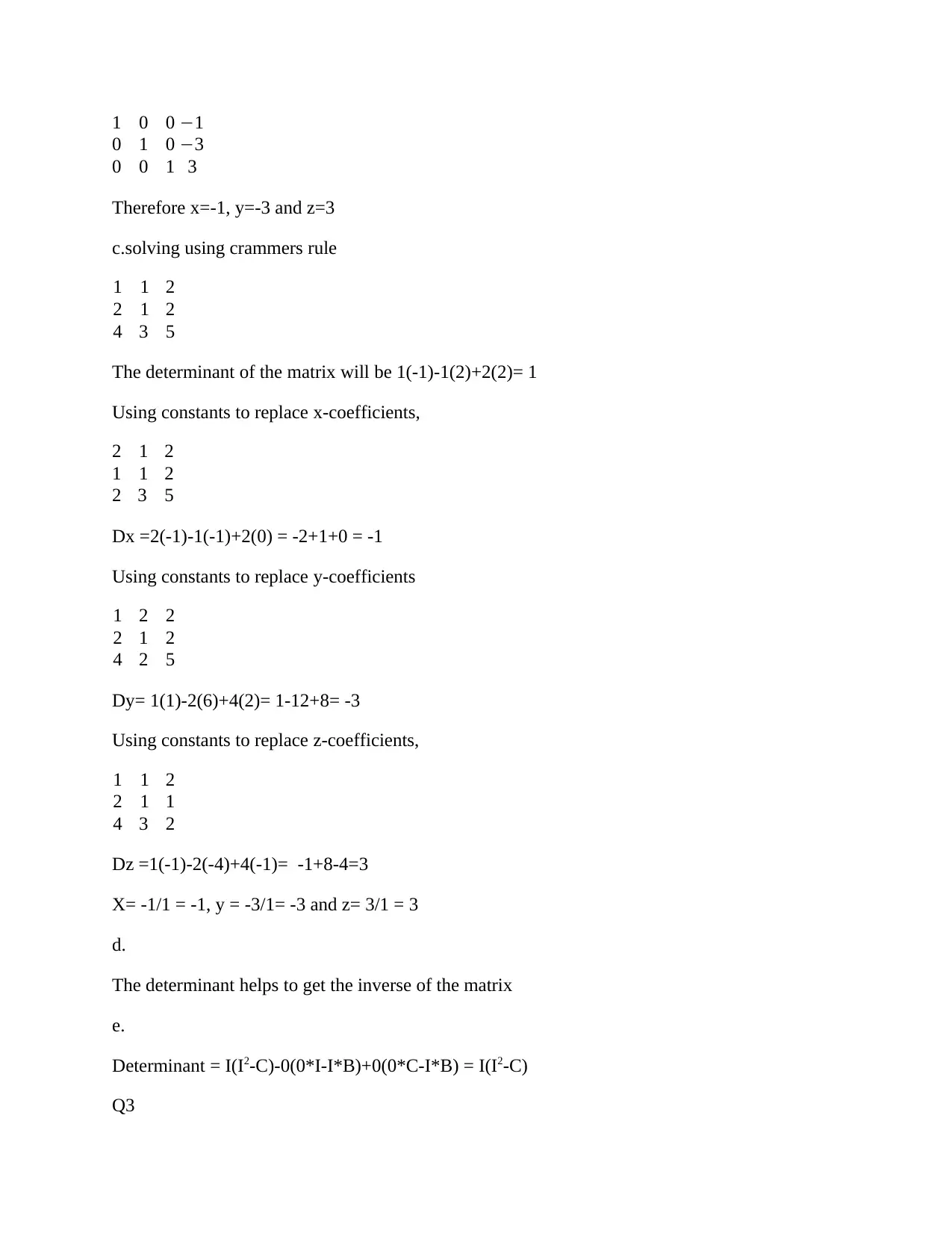
1 0 0
0 1 0
0 0 1
−1
−3
3
Therefore x=-1, y=-3 and z=3
c.solving using crammers rule
1 1 2
2 1 2
4 3 5
The determinant of the matrix will be 1(-1)-1(2)+2(2)= 1
Using constants to replace x-coefficients,
2 1 2
1 1 2
2 3 5
Dx =2(-1)-1(-1)+2(0) = -2+1+0 = -1
Using constants to replace y-coefficients
1 2 2
2 1 2
4 2 5
Dy= 1(1)-2(6)+4(2)= 1-12+8= -3
Using constants to replace z-coefficients,
1 1 2
2 1 1
4 3 2
Dz =1(-1)-2(-4)+4(-1)= -1+8-4=3
X= -1/1 = -1, y = -3/1= -3 and z= 3/1 = 3
d.
The determinant helps to get the inverse of the matrix
e.
Determinant = I(I2-C)-0(0*I-I*B)+0(0*C-I*B) = I(I2-C)
Q3
0 1 0
0 0 1
−1
−3
3
Therefore x=-1, y=-3 and z=3
c.solving using crammers rule
1 1 2
2 1 2
4 3 5
The determinant of the matrix will be 1(-1)-1(2)+2(2)= 1
Using constants to replace x-coefficients,
2 1 2
1 1 2
2 3 5
Dx =2(-1)-1(-1)+2(0) = -2+1+0 = -1
Using constants to replace y-coefficients
1 2 2
2 1 2
4 2 5
Dy= 1(1)-2(6)+4(2)= 1-12+8= -3
Using constants to replace z-coefficients,
1 1 2
2 1 1
4 3 2
Dz =1(-1)-2(-4)+4(-1)= -1+8-4=3
X= -1/1 = -1, y = -3/1= -3 and z= 3/1 = 3
d.
The determinant helps to get the inverse of the matrix
e.
Determinant = I(I2-C)-0(0*I-I*B)+0(0*C-I*B) = I(I2-C)
Q3
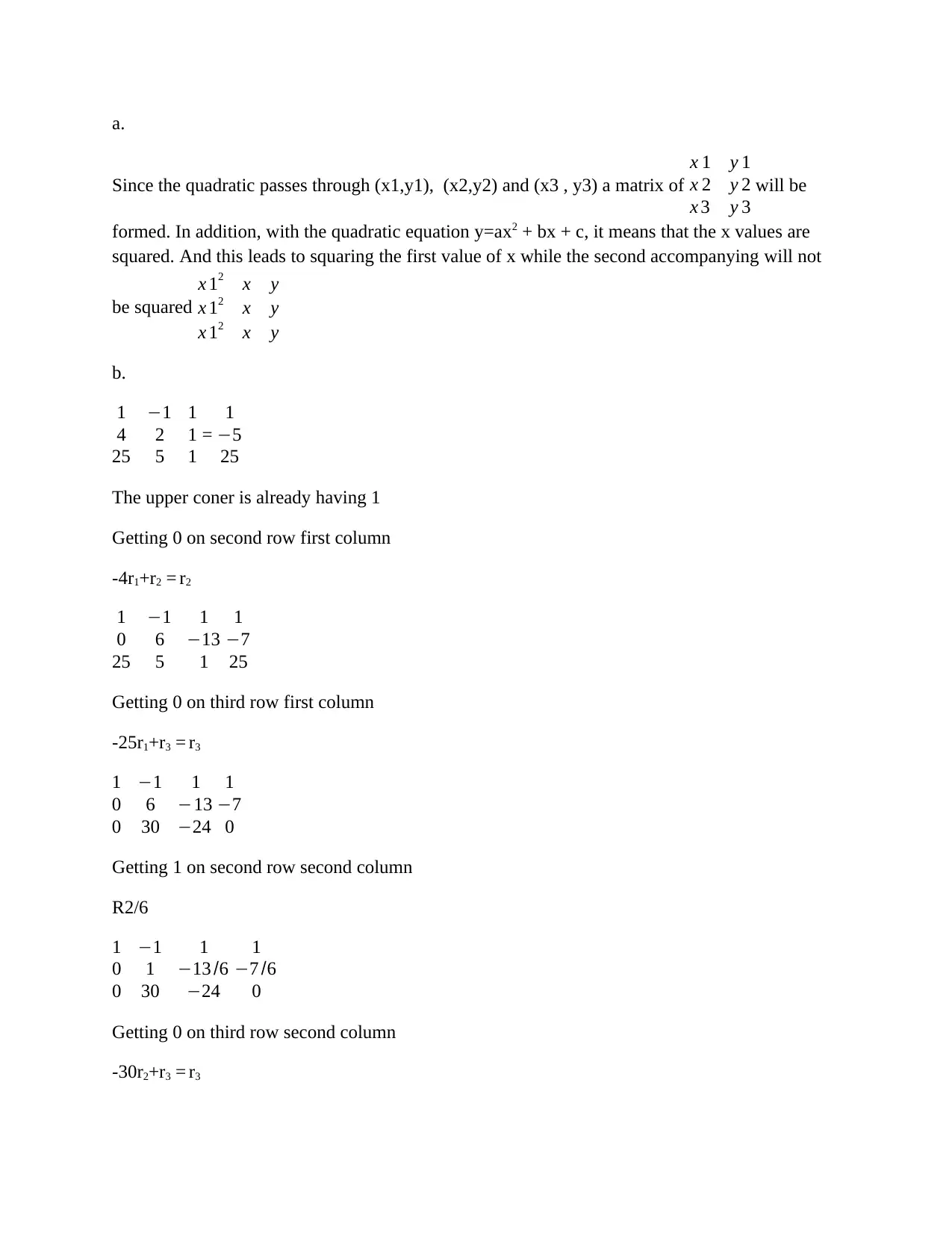
a.
Since the quadratic passes through (x1,y1), (x2,y2) and (x3 , y3) a matrix of
x 1 y 1
x 2 y 2
x 3 y 3
will be
formed. In addition, with the quadratic equation y=ax2 + bx + c, it means that the x values are
squared. And this leads to squaring the first value of x while the second accompanying will not
be squared
x 12 x y
x 12 x y
x 12 x y
b.
1 −1 1
4 2 1
25 5 1
=
1
−5
25
The upper coner is already having 1
Getting 0 on second row first column
-4r1+r2 = r2
1 −1 1
0 6 −13
25 5 1
1
−7
25
Getting 0 on third row first column
-25r1+r3 = r3
1 −1 1
0 6 −13
0 30 −24
1
−7
0
Getting 1 on second row second column
R2/6
1 −1 1
0 1 −13 /6
0 30 −24
1
−7 /6
0
Getting 0 on third row second column
-30r2+r3 = r3
Since the quadratic passes through (x1,y1), (x2,y2) and (x3 , y3) a matrix of
x 1 y 1
x 2 y 2
x 3 y 3
will be
formed. In addition, with the quadratic equation y=ax2 + bx + c, it means that the x values are
squared. And this leads to squaring the first value of x while the second accompanying will not
be squared
x 12 x y
x 12 x y
x 12 x y
b.
1 −1 1
4 2 1
25 5 1
=
1
−5
25
The upper coner is already having 1
Getting 0 on second row first column
-4r1+r2 = r2
1 −1 1
0 6 −13
25 5 1
1
−7
25
Getting 0 on third row first column
-25r1+r3 = r3
1 −1 1
0 6 −13
0 30 −24
1
−7
0
Getting 1 on second row second column
R2/6
1 −1 1
0 1 −13 /6
0 30 −24
1
−7 /6
0
Getting 0 on third row second column
-30r2+r3 = r3
⊘ This is a preview!⊘
Do you want full access?
Subscribe today to unlock all pages.

Trusted by 1+ million students worldwide
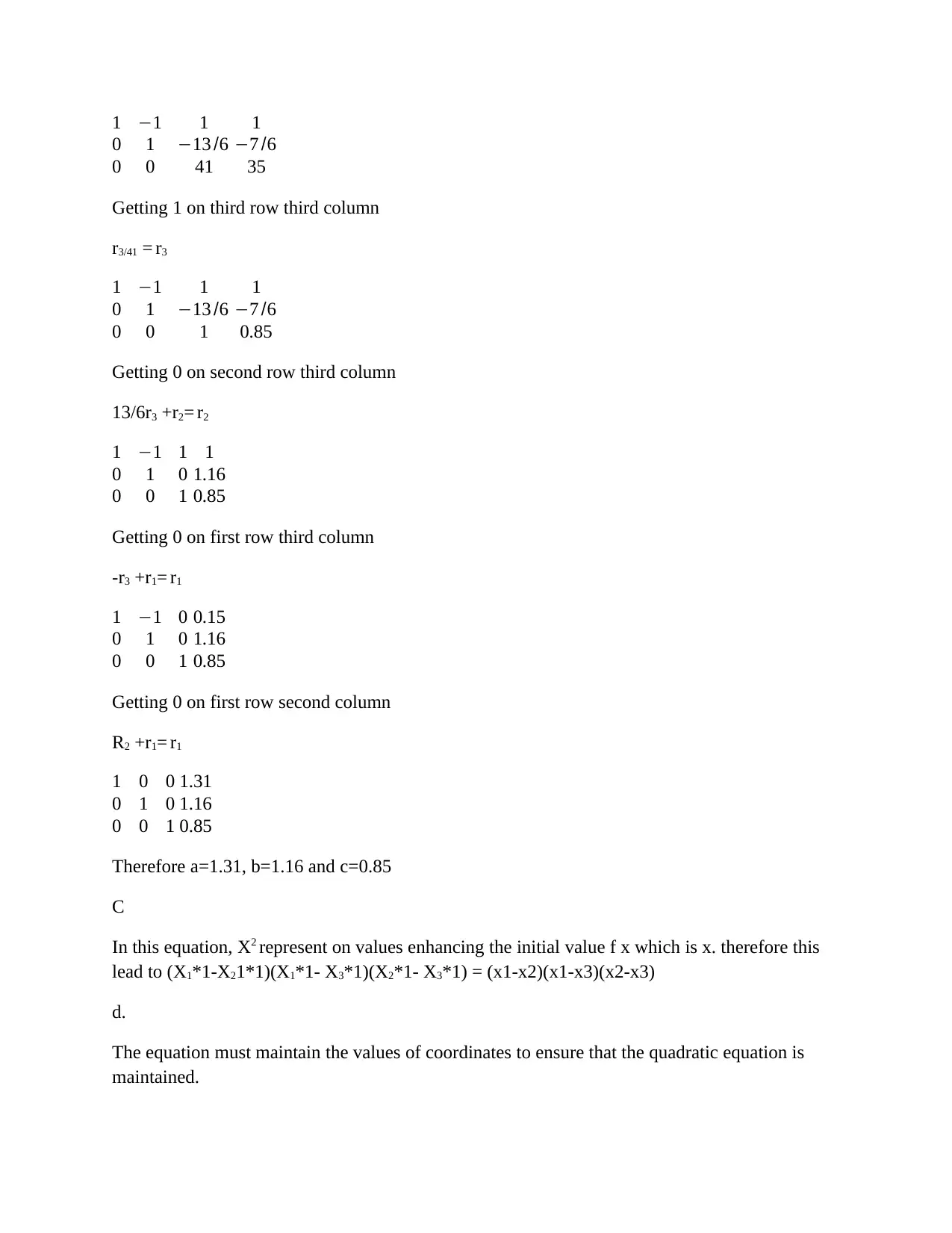
1 −1 1
0 1 −13 /6
0 0 41
1
−7 /6
35
Getting 1 on third row third column
r3/41 = r3
1 −1 1
0 1 −13 /6
0 0 1
1
−7 /6
0.85
Getting 0 on second row third column
13/6r3 +r2= r2
1 −1 1
0 1 0
0 0 1
1
1.16
0.85
Getting 0 on first row third column
-r3 +r1= r1
1 −1 0
0 1 0
0 0 1
0.15
1.16
0.85
Getting 0 on first row second column
R2 +r1= r1
1 0 0
0 1 0
0 0 1
1.31
1.16
0.85
Therefore a=1.31, b=1.16 and c=0.85
C
In this equation, X2 represent on values enhancing the initial value f x which is x. therefore this
lead to (X1*1-X21*1)(X1*1- X3*1)(X2*1- X3*1) = (x1-x2)(x1-x3)(x2-x3)
d.
The equation must maintain the values of coordinates to ensure that the quadratic equation is
maintained.
0 1 −13 /6
0 0 41
1
−7 /6
35
Getting 1 on third row third column
r3/41 = r3
1 −1 1
0 1 −13 /6
0 0 1
1
−7 /6
0.85
Getting 0 on second row third column
13/6r3 +r2= r2
1 −1 1
0 1 0
0 0 1
1
1.16
0.85
Getting 0 on first row third column
-r3 +r1= r1
1 −1 0
0 1 0
0 0 1
0.15
1.16
0.85
Getting 0 on first row second column
R2 +r1= r1
1 0 0
0 1 0
0 0 1
1.31
1.16
0.85
Therefore a=1.31, b=1.16 and c=0.85
C
In this equation, X2 represent on values enhancing the initial value f x which is x. therefore this
lead to (X1*1-X21*1)(X1*1- X3*1)(X2*1- X3*1) = (x1-x2)(x1-x3)(x2-x3)
d.
The equation must maintain the values of coordinates to ensure that the quadratic equation is
maintained.
Paraphrase This Document
Need a fresh take? Get an instant paraphrase of this document with our AI Paraphraser
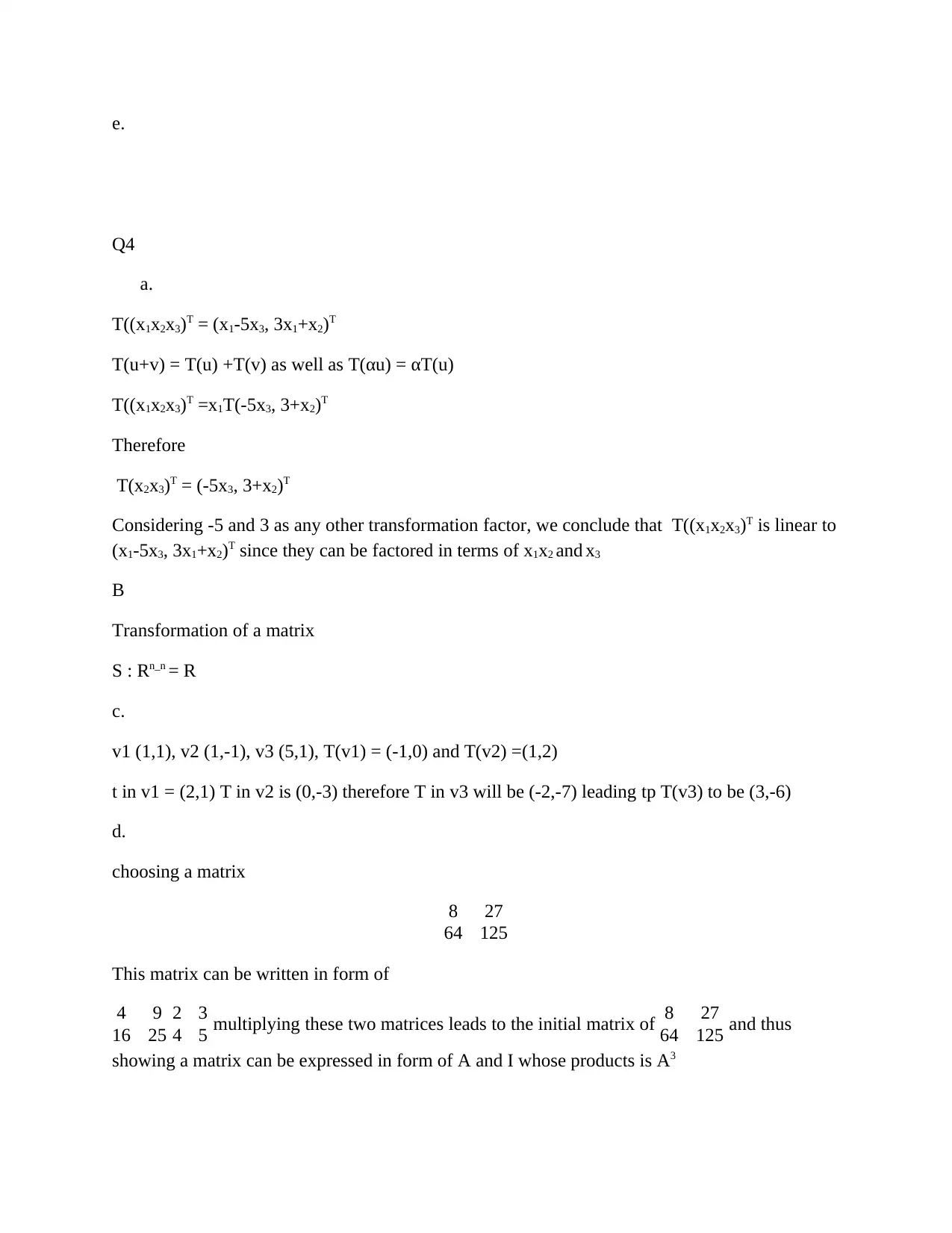
e.
Q4
a.
T((x1x2x3)T = (x1-5x3, 3x1+x2)T
T(u+v) = T(u) +T(v) as well as T(αu) = αT(u)
T((x1x2x3)T =x1T(-5x3, 3+x2)T
Therefore
T(x2x3)T = (-5x3, 3+x2)T
Considering -5 and 3 as any other transformation factor, we conclude that T((x1x2x3)T is linear to
(x1-5x3, 3x1+x2)T since they can be factored in terms of x1x2 and x3
B
Transformation of a matrix
S : Rn_n = R
c.
v1 (1,1), v2 (1,-1), v3 (5,1), T(v1) = (-1,0) and T(v2) =(1,2)
t in v1 = (2,1) T in v2 is (0,-3) therefore T in v3 will be (-2,-7) leading tp T(v3) to be (3,-6)
d.
choosing a matrix
8 27
64 125
This matrix can be written in form of
4 9
16 25
2 3
4 5 multiplying these two matrices leads to the initial matrix of 8 27
64 125 and thus
showing a matrix can be expressed in form of A and I whose products is A3
Q4
a.
T((x1x2x3)T = (x1-5x3, 3x1+x2)T
T(u+v) = T(u) +T(v) as well as T(αu) = αT(u)
T((x1x2x3)T =x1T(-5x3, 3+x2)T
Therefore
T(x2x3)T = (-5x3, 3+x2)T
Considering -5 and 3 as any other transformation factor, we conclude that T((x1x2x3)T is linear to
(x1-5x3, 3x1+x2)T since they can be factored in terms of x1x2 and x3
B
Transformation of a matrix
S : Rn_n = R
c.
v1 (1,1), v2 (1,-1), v3 (5,1), T(v1) = (-1,0) and T(v2) =(1,2)
t in v1 = (2,1) T in v2 is (0,-3) therefore T in v3 will be (-2,-7) leading tp T(v3) to be (3,-6)
d.
choosing a matrix
8 27
64 125
This matrix can be written in form of
4 9
16 25
2 3
4 5 multiplying these two matrices leads to the initial matrix of 8 27
64 125 and thus
showing a matrix can be expressed in form of A and I whose products is A3

⊘ This is a preview!⊘
Do you want full access?
Subscribe today to unlock all pages.

Trusted by 1+ million students worldwide
1 out of 9
Related Documents
Your All-in-One AI-Powered Toolkit for Academic Success.
+13062052269
info@desklib.com
Available 24*7 on WhatsApp / Email
![[object Object]](/_next/static/media/star-bottom.7253800d.svg)
Unlock your academic potential
Copyright © 2020–2025 A2Z Services. All Rights Reserved. Developed and managed by ZUCOL.





